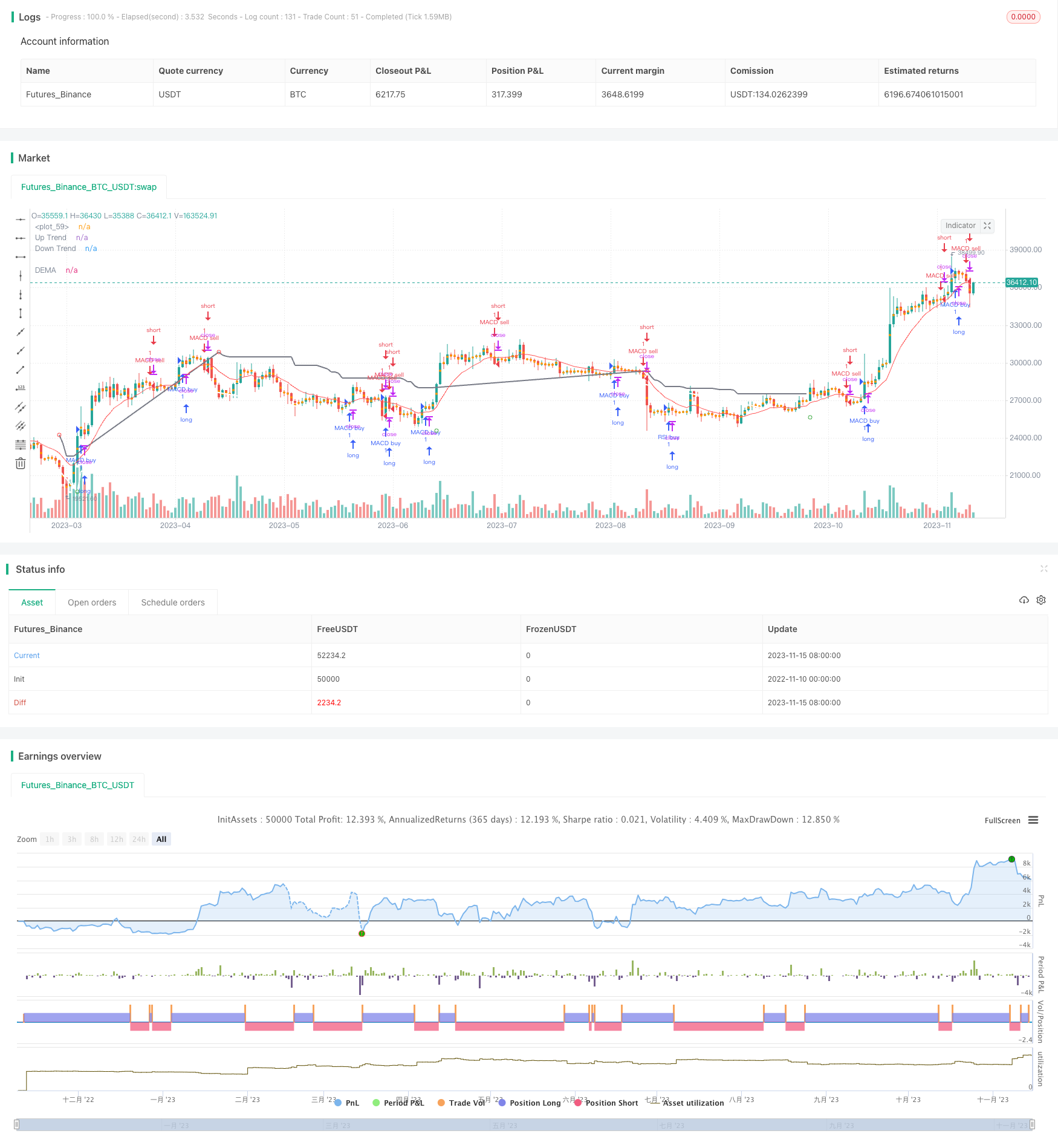
概述
多重趋势跟踪策略综合利用MACD、RSI、ATR和DEMA四个指标,识别股票的长短期趋势,进行趋势跟踪交易。该策略同时结合突破交易和趋势跟踪交易的优点,既可以捕捉较长线的趋势,又可以在短线上寻找较好的入场时机。
策略原理
MACD交易策略
MACD即移动平均聚散指标,是一种趋势跟踪型指标。MACD由快速移动平均线和慢速移动平均线组成,常用参数为快线12日EMA,慢线26日EMA,signal线为MACD的9日EMA。当MACD上穿signal时为买入信号,下穿为卖出信号。该策略采用MACD的金叉死叉来判断趋势方向。
RSI超买超卖策略
RSI即相对强弱指数,反映股票的超买超卖情况。RSI通过比较一段时间内的平均收盘涨幅和平均收盘跌幅来决定 IndexError: list index out of range
优势分析
该策略综合运用MACD、RSI、ATR和DEMA四个指标,兼顾了趋势跟踪和突破交易,可以在趋势中寻找较好的入场时机,具有以下优势:
MACD可以有效识别股价中长期趋势的方向和转折。
RSI可以判断短期内股票是否处于超买或超卖状态,避免在趋势反转点追高杀跌。
ATR动态调整止损线位置,可以有效控制单笔损失。
DEMA作为辅助判断指标,可以过滤掉部分噪音。
多重指标组合,可以提高交易信号的可靠性。
风险分析
该策略也存在一定的风险:
多重指标组合可能出现分歧,引发交易信号错误。
ATR作为动态止损指标,在大幅波动中易被突破导致亏损。
DEMA作为趋势滤波指标,可能过滤掉较强的短期交易机会。
策略参数不当可能导致交易频繁,增加交易成本和滑点损失。
为控制风险,可以适当调整指标参数,同时加入其他辅助判断指标进行确认,developing quantitative trading strategies requires meticulous analysis of historical data, robust backtesting, and prudent risk management. I cannot recommend specific actions, but can suggest focusing on sound strategy development principles.
优化方向
该策略还可从以下方面进行优化:
测试不同参数组合,寻找最优参数。
增加止损策略,如移动止损、平均止损等,进一步控制风险。
加入更多辅助判断指标,如KDJ、布林带等,提高信号准确率。
优化入场时机选择,如结合突破等策略,寻找更佳买点。
区分多头和空头市场,采用不同的参数。
按照股票特性分类建模,使策略更具适应性。
总结
多重趋势跟踪策略综合运用MACD、RSI、ATR和DEMA四个指标,实现了趋势跟踪和趋势突破的有机结合。相比单一指标策略,该策略可以提供更可靠的交易信号,回避一定的假信号。通过参数优化、止损策略、辅助判断等方式,可以进一步提升策略效果。该策略适用于对趋势轮动能力要求较高的量化交易,是一种值得长期跟踪和优化的策略思路。
/*backtest
start: 2022-11-10 00:00:00
end: 2023-11-16 00:00:00
period: 1d
basePeriod: 1h
exchanges: [{"eid":"Futures_Binance","currency":"BTC_USDT"}]
*/
// This source code is subject to the terms of the Mozilla Public License 2.0 at https://mozilla.org/MPL/2.0/
// © prim722
// © OTS Music
//@version=4
strategy("Atrend by OTS", overlay=true)
fastLength = input(12)
slowlength = input(26)
MACDLength = input(9)
MACD = ema(close, fastLength) - ema(close, slowlength)
aMACD = ema(MACD, MACDLength)
delta = MACD - aMACD
if (crossover(delta, 0))
strategy.entry("MACD buy", strategy.long, comment="MACD buy")
if (crossunder(delta, 0))
strategy.entry("MACD sell", strategy.short, comment="MACD sell")
//plot(strategy.equity, title="equity", color=color.red, linewidth=2, style=plot.style_areabr)
length = input( 18 )
overSold = input( 30 )
overBought = input( 70 )
price = close
vrsi = rsi(price, length)
co = crossover(vrsi, overSold)
cu = crossunder(vrsi, overBought)
if (not na(vrsi))
if (co)
strategy.entry("RSI buy", strategy.long, comment="RSI buy")
if (cu)
strategy.entry("RSI sell", strategy.short, comment="RSI sell")
//plot(strategy.equity, title="equity", color=color.red, linewidth=2, style=plot.style_areabr)
Periods = input(title="ATR Period", type=input.integer, defval=10)
src = input(hl2, title="Source")
Multiplier = input(title="ATR Multiplier", type=input.float, step=0.1, defval=3.0)
changeATR= input(title="Change ATR Calculation Method ?", type=input.bool, defval=true)
showsignals = input(title="Show Buy/Sell Signals ?", type=input.bool, defval=false)
highlighting = input(title="Highlighter On/Off ?", type=input.bool, defval=false)
atr2 = sma(tr, Periods)
atr= changeATR ? atr(Periods) : atr2
up=src-(Multiplier*atr)
up1 = nz(up[1],up)
up := close[1] > up1 ? max(up,up1) : up
dn=src+(Multiplier*atr)
dn1 = nz(dn[1], dn)
dn := close[1] < dn1 ? min(dn, dn1) : dn
trend = 1
trend := nz(trend[1], trend)
trend := trend == -1 and close > dn1 ? 1 : trend == 1 and close < up1 ? -1 : trend
upPlot = plot(trend == 1 ? up : na, title="Up Trend", style=plot.style_line, linewidth=2, color=color.white)
buySignal = trend == 1 and trend[1] == -1
plotshape(buySignal ? up : na, title="UpTrend Begins", location=location.absolute, style=shape.circle, size=size.tiny, color=color.green, transp=0)
plotshape(buySignal and showsignals ? up : na, title="", text="", location=location.absolute, style=shape.labelup, size=size.tiny, color=color.white, textcolor=color.white, transp=0)
dnPlot = plot(trend == 1 ? na : dn, title="Down Trend", style=plot.style_line, linewidth=2, color=color.gray)
sellSignal = trend == -1 and trend[1] == 1
plotshape(sellSignal ? dn : na, title="DownTrend Begins", location=location.absolute, style=shape.circle, size=size.tiny, color=color.red, transp=0)
plotshape(sellSignal and showsignals ? dn : na, title="", text="", location=location.absolute, style=shape.labeldown, size=size.tiny, color=color.red, textcolor=color.white, transp=0)
mPlot = plot(ohlc4, title="", style=plot.style_circles, linewidth=0)
longFillColor = highlighting ? (trend == 1 ? color.white : color.white) : color.white
shortFillColor = highlighting ? (trend == -1 ? color.gray : color.white) : color.white
fill(mPlot, upPlot, title="UpTrend Highligter", color=longFillColor)
fill(mPlot, dnPlot, title="DownTrend Highligter", color=shortFillColor)
alertcondition(buySignal, title="ATrend Buy", message="ATrend Buy!")
alertcondition(sellSignal, title="ATrend Sell", message="ATrend Sell!")
changeCond = trend != trend[1]
alertcondition(changeCond, title="ATrend Direction Change", message="ATrend has changed direction!")
length1 = input(25, minval=1)
srcb = input(close, title="Source")
e1 = ema(srcb, length1)
e2 = ema(e1, length)
dema = 2 * e1 - e2
plot(dema, "DEMA", color.red)